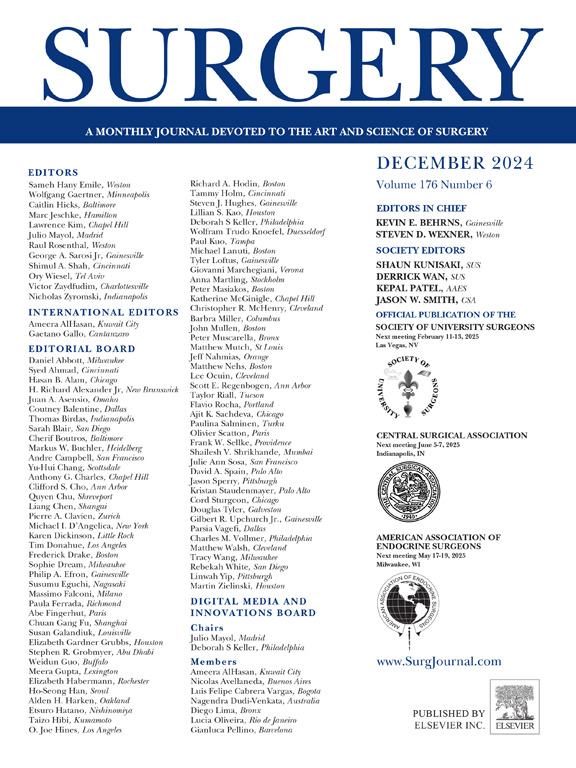Prediction of the need for surgery in infants with necrotizing enterocolitis: A systematic review and meta-analysis
IF 2.7
2区 医学
Q1 SURGERY
引用次数: 0
Abstract
Background
Surgical necrotizing enterocolitis is associated with high rates of mortality and morbidity. However, there is a lack of consensus on the optimal candidates for surgical interventions. Accurate identification of the need for surgery is crucial for improving clinical outcome. The aim of this study was to evaluate the diagnostic performance of predictors of surgical intervention for neonates with necrotizing enterocolitis.
Method
PubMed, Embase, and the Cochrane Database of Systematic Reviews were searched. We included studies that assessed the prediction of the need for surgical intervention in infants with necrotizing enterocolitis. We performed a meta-analysis of diagnostic accuracy of predictors (including clinical, laboratory, radiologic, and ultrasonographic parameters) by analyzing the pooled sensitivity, specificity, positive predictive value, negative predictive value, diagnostic odds ratio and area under the receiver operating characteristic curve.
Results
A total of 53 studies with 6,046 participants were included in this review. Pooled analyses were performed for 13 predictive factors. Abdominal distention had a high sensitivity (93%) and low specificity (26%), whereas abdominal wall erythema showed a low sensitivity (30%) and high specificity (93%). Thrombocytopenia was highly specific (85%) but poorly sensitive. Both signs of fixed intestinal loop and portal venous gas on radiography showed excellent specificities, although their sensitivities were poor. Ascites on sonography had a relatively good overall predictive performance with pooled area under the receiver operating characteristic curve of 0.84.
Conclusion
The diagnostic performance of the investigated predictors of surgical necrotizing enterocolitis varied greatly. Several predictors showed promise in identifying optimal candidates to receive surgery for necrotizing enterocolitis and appropriate integration of these parameters would be useful.

坏死性小肠结肠炎患儿手术需求的预测:一项系统回顾和荟萃分析
手术坏死性小肠结肠炎具有高死亡率和发病率。然而,对于手术干预的最佳候选人缺乏共识。准确识别手术的需要对改善临床结果至关重要。本研究的目的是评估手术干预新生儿坏死性小肠结肠炎的预测指标的诊断性能。方法检索pubmed、Embase和Cochrane系统评价数据库。我们纳入了评估婴儿坏死性小肠结肠炎手术干预需求预测的研究。我们通过分析汇总敏感性、特异性、阳性预测值、阴性预测值、诊断优势比和受试者工作特征曲线下面积,对预测因子(包括临床、实验室、放射学和超声参数)的诊断准确性进行meta分析。结果本综述共纳入53项研究,涉及6046名受试者。对13个预测因素进行汇总分析。腹胀的敏感性高(93%),特异性低(26%),腹壁红斑的敏感性低(30%),特异性高(93%)。血小板减少症具有高度特异性(85%),但敏感性较差。固定肠袢和门静脉气体的x线征象均具有良好的特异性,但其敏感性较差。超声对腹水的总体预测效果较好,受者工作特征曲线下的汇总面积为0.84。结论所调查的手术坏死性小肠结肠炎预测因子的诊断效果差异较大。几个预测指标显示有希望确定接受坏死性小肠结肠炎手术的最佳候选人,适当整合这些参数将是有用的。
本文章由计算机程序翻译,如有差异,请以英文原文为准。
求助全文
约1分钟内获得全文
求助全文
来源期刊

Surgery
医学-外科
CiteScore
5.40
自引率
5.30%
发文量
687
审稿时长
64 days
期刊介绍:
For 66 years, Surgery has published practical, authoritative information about procedures, clinical advances, and major trends shaping general surgery. Each issue features original scientific contributions and clinical reports. Peer-reviewed articles cover topics in oncology, trauma, gastrointestinal, vascular, and transplantation surgery. The journal also publishes papers from the meetings of its sponsoring societies, the Society of University Surgeons, the Central Surgical Association, and the American Association of Endocrine Surgeons.
 求助内容:
求助内容: 应助结果提醒方式:
应助结果提醒方式:


